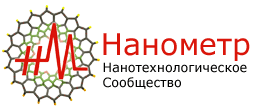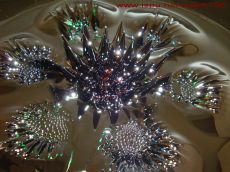3 марта начинается курс лекций "Nanotechnology and Nanosensors" от Technion (Israel Institute of Technology) на Coursera. Продолжительность - , лектор - проф. Хоссам Хайк, (Prof. Hossam Haick, Head of the Laboratory for Nanomaterial-Based Devices (LNBD) and Volatile Biomarkers)
Learn about novel sensing tools that make use of nanotechnology to screen, detect and monitor various events in personal or professional life. Together, we will lay the groundwork for infinite innovative applications, starting from diagnosis and treatments of diseases, continuing with quality control of goods and environmental aspects, and ending with monitoring security issues.
About the Course
Nanotechnology and nanosensors are broad, interdisciplinary areas that encompass (bio)chemistry, physics, biology, materials science, electrical engineering and more. The present course will provide a survey on some of the fundamental principles behind nanotechnology and nanomaterials and their vital role in novel sensing properties and applications. The course will discuss interesting interdisciplinary scientific and engineering knowledge at the nanoscale to understand fundamental physical differences at the nanosensors. By the end of the course, students will understand the fabrication, characterization, and manipulation of nanomaterials, nanosensors, and how they can be exploited for new applications. Also, students will apply their knowledge of nanotechnology and nanosensors to a topic of personal interest in this course.
Course Syllabus
Week 1: Introduction to Nanotechnology: Definition of nanotechnology; main features of nanomaterials; types of nanostructures (0D, 1D, and 2D structures); nanocomposites; and main chemical/physical/electrical/optical properties of nanomaterials.
Week 2: Introduction to Nanotechnology - continue: Methods for characterizing the nanomaterials: Atomic Force Microscopy (AFM), Scanning Electron Microscopy (SEM), Transmission Electron Microscopy (TEM), and spectroscopy- and spectrometry-based surface analysis techniques. Fabrication of sensors by bottom-up and top-down approaches; self-assembly of nanostructures; and examples for nanotechnology application
Week 3: Introduction to Sensors' Science and Technology: Definition of sensors; main elements of sensors; similarities between living organisms and artificial sensors; working mechanism of physical sensation (seeing, hearing, and feeling) and chemical sensation (smelling and tasting); the parameters used for characterizing the performance of sensors: accuracy, precision, sensitivity, detection limit, dynamic range, selectivity, linearity, resolution, response time, hysteresis, and life cycle.
Week 4: Metal nanoparticle-based Sensors: Definition of nanoparticle; features of nanoparticles; and production of nanoparticles by physical approach (laser ablation) and chemical approaches (Brust method, seed-mediated growth, etc.).
Week 5: Quantum Dot Sensors: Definition of quantum dot; fabrication techniques of quantum dots; Macroscopic and microscopic photoluminescence measurements; applications of quantum dots as multimodal contrast agents in bioimaging; and application of quantum dots as biosensors.
Week 6: Nanowire-based Sensors: Definition of nanowires; features of nanowires; fabrication of individual nanowire by top-down approaches and bottom-up approaches; and fabrication of nanowire arrays (fluidic channel, blown bubble film, contact printing, spray coating, etc.).
Week 7: Carbon Nanotubes-based Sensors: Definition of carbon nanotube; features of carbon nanotubes; synthesis of carbon nanotubes; fabrication and working principles of sensors based on individual carbon nanotube; fabrication and working principles of sensors based on random array of carbon nanotubes.
Week 8: Sensors Based on Nanostructures of Metal Oxide: Synthesis of metal oxide structures by dry and wet methods; types of metal oxide gas sensors (0D, 1D, and 2D); defect chemistry of the metal oxide sensors; sensing mechanism of metal-oxide gas sensors; and porous metal-oxide structures for improved sensing applications.
Week 9: Mass-Sensitive Nanosensors: Working principle of sensors based on polymeric nanostructures; sensing mechanism and applications of nanomaterial-based of chemiresistors and field effect transistors of (semi-)conductive polymers, w/o inorganic materials.
Week 10: Arrays of Nanomaterial-based Sensors: A representative example for the imitation of human senses by means of nanotechnology and nanosensors: electronic skin based on nanotechnology.
Recommended Background
Any background is science (chemistry, biology, physics), technology and/or engineering would fit the course.
Suggested Readings
The lectures are designed to be self-contained. For additional information, you are welcome (but do not require) to refer to:
Jiří Janata, Principles of Chemical Sensors, Springer, 2d Edition (1989).
Roger George Jackson, Novel Sensors and Sensing, CRC Press (2004).
Florinel-Gabriel Banica, Chemical Sensors and Biosensors: Fundamentals and Applications, John Wiley and Sons (2012).
Ramsden Jeremy, Nanotechnology, an Introduction. Elsevier (2011).
Course Format
This course will have three types of graded activities that will be included in your overall course grade. These include:
Weekly quizzes: At the end of each class, you will be asked to complete a quiz. These quizzes will provide you with an opportunity to review what you have learned throughout the week. You may take these quizzes as many times as you wish. Once answered correctly, the weekly quizzes will count for 20% of your overall course grade.
Forum activity: During the course, you will be asked to participate in three assigned discussions. This activity includes three parts: answering an open-ended question, providing feedback to peers, and ranking their contribution. The forum activity will count for 20% of your overall course grade, according to the average of votes, posts, and views.
Final project: At the end of the course you will be asked to complete a final project. The final project will be conducted in groups of 3-to4 students. It will consist of a written report that focuses on the utilization of nanotechnology and nanosensors to imitate a specific sense that relates to human senses: vision, hearing, taste, smell, or touch. Other non-specific senses such as balance and pains can be included as well.
The final project should include, but not confined to: (a) multidisciplinary presentation and discussion of the overall design approach; (b) fabrication; (c) characterization; and (d) application of the targeted artificial sense. The report shall NOT exceed 10 pages, written in 11-12 font size, 1.5 line spacing, and 2.5 cm margins from each side of the document. The final project will be graded by your peers, according to a grading rubric, accounting for 60% of your overall course grade.

